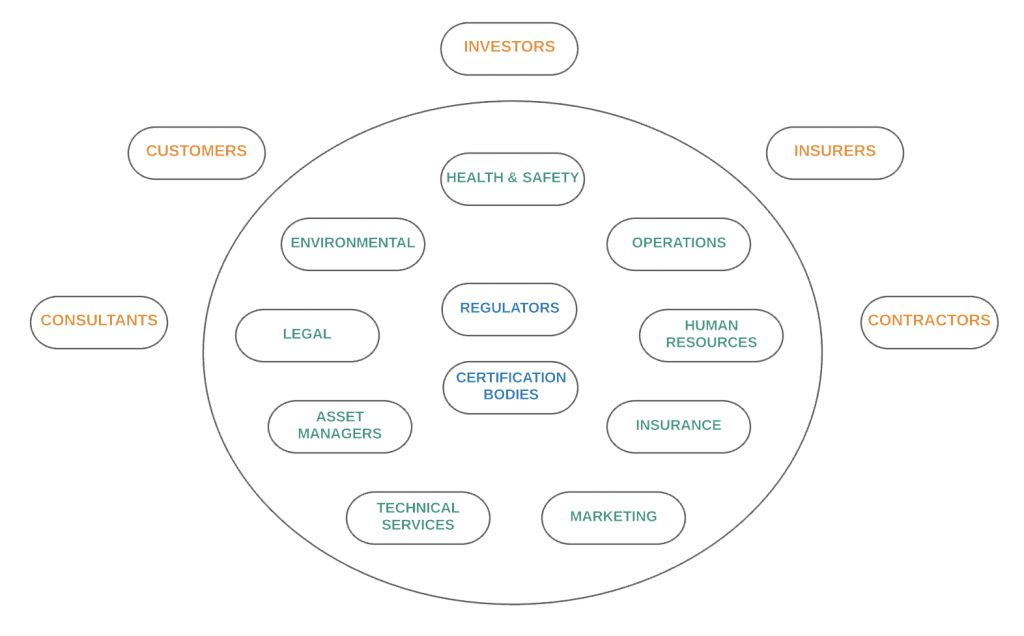EHS Compliance Management
EHS Compliance Management refers to the activities, procedures and policies implemented by companies to comply with relevant regulations. The objective is to efficiently achieve regulatory compliance and to improve the environmental, health and safety performance of a company. Every employee, as well as several external stakeholders, have a role to play in safety. Consequently, careful consideration should be applied to every detail of your EHS compliance management strategy.

The Return on Investment of Compliance Management
EHS compliance management is a subset of EHS Management. Please refer to our notes on the ROI of EHS Management to understand the benefits of compliance management.
A Compliance Management Implementation Checklist
As we mentioned earlier, implementing compliance management systems is particularly challenging. The range of stakeholders, information management requirements and workflow coordination can be daunting. Achieving compliance with grassroots ownership and engagement across the organization (as opposed to enforcement) can feel like an impossible goal. The complexity of compliance management increases in distributed organizations where there are more facilities and remote teams are harder to influence.
However, EHS compliance is not optional. So how do we decompose the problem into elements that can be incrementally added to a management program? How do we think about compliance so that if we have one building or one thousand buildings, we can manage compliance with confidence and consistency?
Step 1: Understand the Compliance Regulations
The EHS compliance management journey starts with an understanding of the regulations. You are not required to be an expert, but you certainly need a high level understanding of federal and state or provincial requirements that are applicable to each of your facilities. Armed with this knowledge you can formulate a compliance management strategy before getting into the details of tactics execution.
14 Categories of Health and Safety Regulations for Real Estate
- Confined Spaces
- Contractor Safety
- Employee Rights
- First Aid
- Hot Work
- Ladders, Scaffolds, Roof
- Legionella
- Lifts and Hoists
- Lockout Tag-out
- Material Handling
- Noise
- Visitor Safety
- WHMIS
- Working Alone
12 Categories of Environmental Regulations for Real Estate
- Aboveground Tanks (AST)
- Air Quality
- Asbestos
- Contaminated Sites
- Hazardous Substances
- Mould
- Ozone Depleting Substances
- PCB’s
- Radon
- Spills
- Underground Tanks (UST)
- Waste Management
Step 2: Define Your EHS Compliance Management Strategy
Your compliance management strategy will be shaped by several considerations, most important of which is likely to be executive support and budget. Executive support is widely recognized as a critical success factor and crucial in securing resources and an adequate budget. Without executive support you will face an uphill battle in establishing a grassroots culture of safety and compliance.
Whatever your initial constraints, it is wise to map out a strategy that has the elements required to scale and evolve in response to business pressures or opportunities. Here are a few strategic considerations:
- What role will the executive team play in launching and supporting the compliance program. Can you clearly articulate the important metrics or objectives in your compliance program that will create a material business impact? The importance of this aligning business outcomes with compliance cannot be overstated.
- Will you adopt a structured international management standard or framework such as OHSAS 18001, ANSI Z10 or ISO 14001? Aligning with management standards may be a requirement rather than a choice but establishing a management philosophy and goals from the outset is crucial. Compliance and safety has many moving parts and is constantly evolving – a framework connects the composable elements of your program so that they always align with vision and objectives.
- Will you manage the compliance program with an internal team or using an external service? We most commonly see EHS consultants leveraged for their specialized knowledge of regulations and assessments while internal teams follow daily compliance and safety procedures.
- Finally, how will you translate executive support into grassroots adoption of safety and compliance? Without the support, engagement and adoption of safety and compliance by frontline employees you will be faced with an enforcement program. Enforcement is hard work. Engagement creates resilient teams and sustainable outcomes.
Step 3: Define a Compliance Information Management Strategy
Information management is a very important aspect of EHS compliance management. Not only is there a wide range of data points to manage across a portfolio, but the information impacts the workflow and reporting requirements of a number of stakeholders.
Organizations all too often use several point solutions in addition to paper forms, email, Microsoft Excel and a document repository. This approach often leads to unacceptable duplication and errors in information management as stakeholder groups independently manage overlapping spreadsheets. As organizations scale, this fragmented information management strategy increasingly inhibits stakeholder collaboration and efficiency while adding excessive amounts of administration and unnecessary cost to compliance management activities.
Companies like Refined Data have addressed this challenge by bringing mobile, enterprise information management software that is specifically designed for EHS and compliance workflows. Shared, actionable, secure and transparent information flows significantly reduce the administrative burden while connecting and coordinating stakeholder activity from the buildings to the boardroom.
The Benefits of Enterprise Information Management for EHS and Compliance
- There is a common description of facility information, assessments, reports, certificates and risk registers.
- Information is actionable and transparent.
- Manage and support stakeholder objectives and performance indicators in real time.
- Efficiently identify, correct, audit and report on non-compliance.
- Front line workers are able to participate in shaping a culture of safety and compliance.
- Place management emphasis on continuous improvement rather than non-compliance.
- Reduce the cost of compliance.
- Reduce the cost of employee training.
- Reduce software integration, data management and data visualization costs.
Enterprise information management software platforms may appear to be costly, but the efficiency and engagement advantages quickly create a positive return on investment. More importantly, these platforms position companies for growth and resilience.